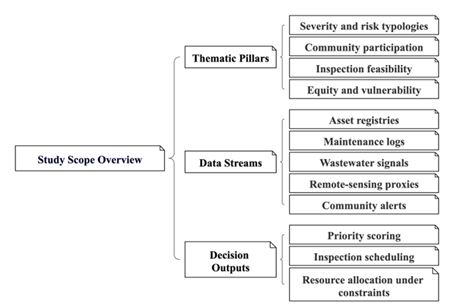Priority Frameworks for Resource Allocation in WASH Infrastructure Inspections
Main Article Content
Abstract
This paper presents a modular, risk-weighted prioritization framework for inspection of rural water, sanitation, and hygiene (WASH) assets where personnel, transport, and diagnostic capacity are constrained and delays elevate health risk. The practical gap is translating multi-criteria evidence and systems insights into capacity-aware, field-ready inspection schedules with uncertainty accounted for. The methodology fuses quality-controlled asset registers, maintenance logs, wastewater signals, remote-sensing proxies, and community alerts; constructs composite priorities from need typologies, severity-weighted risk, time since last inspection, and access limits; and applies Bayesian calibration to quantify and propagate uncertainty. Evaluation uses Root Mean Squared Error (RMSE), bias, calibration, and bootstrap confidence intervals, with risk tiers linked to human health risk assessment (HHRA), entropy-weighted water quality index (EWQI), and nitrate pollution index (NPI). Simulations indicate higher flexibility, resource savings, coverage, and faster mean response time than distance-based or random baselines; priority scores concentrate on high-severity typologies, and confidence intervals widen under low participation, high noise, and long reporting latency. The contribution is a parsimonious, uncertainty-aware scheduling framework that integrates severity, vulnerability, and near-real-time community input with fallback heuristics and human-in-the-loop triage. The approach enables agencies to convert heterogeneous evidence into feasible, equity-aware inspection schedules that improve responsiveness and resource use under scarce capacity.
Article Details

This work is licensed under a Creative Commons Attribution-ShareAlike 4.0 International License.

